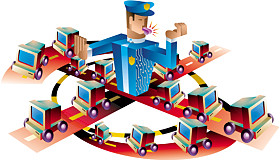Part three of a three-part series
 I’ll readily admit it – I’m fascinated daily with the pace and growth of technology and the capabilities that are only limited by the imaginations of engineers. I’m particularly excited about the merging and emerging capabilities of Third Generation (3G), Fourth Generation (4G) and Long Term Evolution (LTE). In our personal lives, smart phones and tablet computers like the iPad and those running on Google’s Android operating system have opened a wide new world of interconnectedness that allow instant online access wherever you are – and wherever you go. For field officers, this means that future communications, data and video possibilities are truly endless.
I’ll readily admit it – I’m fascinated daily with the pace and growth of technology and the capabilities that are only limited by the imaginations of engineers. I’m particularly excited about the merging and emerging capabilities of Third Generation (3G), Fourth Generation (4G) and Long Term Evolution (LTE). In our personal lives, smart phones and tablet computers like the iPad and those running on Google’s Android operating system have opened a wide new world of interconnectedness that allow instant online access wherever you are – and wherever you go. For field officers, this means that future communications, data and video possibilities are truly endless.
According to industry leaders, as LTE begins to be deployed in 2011, officers on patrol will have access to data and video in vehicles and on hand-held devices. This is encouraging news as it means that the convergence of cellular applications and devices with current antiquated police radio systems has begun. In fact, the military is far ahead of public safety departments in this area, with cellular devices already replacing traditional hand-held radios.
Why? It’s actually quite simple.
Young, tech-savvy recruits to police forces are keenly aware of the benefits that 3G, 4G and LTE can and will provide as they use it every day in their personal lives to text; tweet; get directions; and upload pictures, videos and status updates from their own wireless hand-held devices. As the cellular industry begins offering much faster 4G pipes for broadband applications, running multiple applications has become routine.
With the advent of LTE, that speed and an even larger pipe will make current technology look like the leap from dial-up Internet to fiber. In basic terms, you could say that LTE will be like a super highway of “data packets” consisting of voice, data or video that travel at faster speeds and in larger “packets” than those previously. This dynamic upgrade could be remarkable for policing.
As police embrace the capabilities of emerging technologies and focus less on simple voice radio-based operations, LTE provides the first true capability for interoperable communications nationwide for all emergency services at every level of government. Like today’s cellular services, as you roam from city to city, your device will have a unique IP address which the system will simply identify and then allow you on with authorization.
Public safety officials have waited a decade for the FCC to give them a designated space in the 700 MHz band and that’s expected very soon. As the “next-gen” in cellular technology, LTE will be the best use of that space to fulfill a dream of streaming video, posting data and carrying highly reliable radio voice transmissions on the same device.
This post is part three of a three-part series.
Part one is: “What Open Architecture Systems Mean to a Field Cop”
Part two is: “Brave New World: Wireless Access Technologies and the Impact on Policing”
Mike Bostic was with the LAPD for 34 years. He held every significant command up to Assistant Chief. Mr. Bostic is currently working in communications technology/public safety at Raytheon. He will also provide the closing keynote address on Wednesday Jan 12th at The SMILE (Social Media the Internet and Law Enforcement) Conference in Santa Monica. Find him on Twitter – @mikebostic


